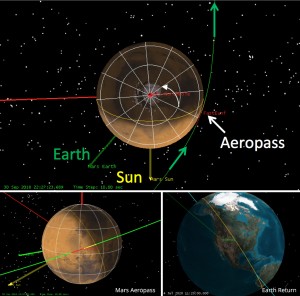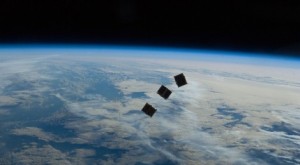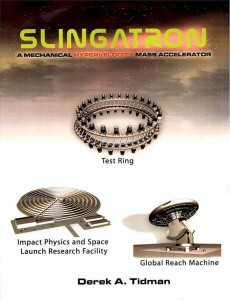Posted at 16:45h
in
Space
by Shen Ge
[caption id="attachment_42" align="alignleft" width="300"]

In 2020, SCIM will embark on a two year journey to Mars to perform a high-speed atmospheric pass collecting tiny dust particles. SCIM will take another half year to return the samples to Earth for detailed analysis. Source: BoldlyGo Institute[/caption]
A nonprofit corporation called BoldlyGo Institute (BGI) is developing a Mars Sample Return mission called the Sample Collection to Investigate Mars (SCIM) which will return the first samples of Martian materials back to Earth. The project is at the preliminary design stage and the goal is ambitious. With a launch date of July 26, 2020, SCIM will journey through space for two years. When it reaches Mars, it will swoop down and collect the dust particles from the Martian atmosphere below 40 km. The SCIM has an aerodynamic aeroshell allowing it to rapidly pass through the atmosphere without being captured by Mars's gravity. The sample capture mechanism for the Mars Sample Return Mission is similar to the successful collection system for the Stardust mission which used aerogel to capture dust particles. After collecting thousands of particles, the spacecraft will leave Mars on August 3, 2022 and return directly to Earth by February 1, 2023 where the sterilized samples will descend by parachutes to the ground.
After collecting thousands of particles, the spacecraft will leave Mars on August 3, 2022 and return directly to Earth by February 1, 2023 where the sterilized samples will descend by parachutes to the ground.
Sample return offers advantages over the current and past robotic missions to Mars where samples have been only analyzed on Mars. Earth-based lab instruments are much more sophisticated than what can be packed into a Mars rover or lander allowing much greater detailed analysis. Furthermore, there is no time limit for analysis; as more advanced instruments are developed, they can be applied on curated samples. Lastly and perhaps speaking most intriguingly of BoldlyGo Institute's philosophy, participation can involve hundreds of scientists and students--many of whom may not be traditionally involved in the Mars science community.
Interested in more of my posts and other writings outside of Impact Hound? Follow me on Twitter:
@shenge86
 3 CubeSats deployed from the ISS in 2013. There is a growing small satellite market. Consider reading Small Satellites: Past., Present, and Future for more information. Photo: NASA[/caption]
Universities, government agencies, and small companies are building more and more small satellites. For years, small satellite companies had no choice but to piggyback on larger payloads as rides to space. These companies have to pay exorbitant fees and often have to wait for years before their satellites or their customers' satellites can be launched. However, as satellites grow ever more sophisticated and as electronic components become ever smaller and cheaper, new companies are forming focused on building a greater quantity of small satellites with rapid turnaround times. The small satellite market is projected to grow from $702.4 million in 2014 to $1887.1 million in 2019, a 21.8% growth rate. Yet, currently, no service exists to exclusively serve these small satellites by launching them at an affordable cost and in a timely fashion.
What is a small satellite? A small satellite is a satellite less than or around 500 kilograms in mass. The small satellite market can be further divided into microsatellites, nanosatellites, and CubeSats. Microsatellites range from 10 to 100 kilograms and often work in a constellation to do the task previously completed by a solitary satellite. Nanosatellites range from 1 to 10 kilograms and can include both single and multiple-unit CubeSats as well as other spacecrafts of any form factor within the weight range. CubeSats are 10 cm x 10 cm x 10 cm cube satellites with a maximum mass of 1 kg. These have been mostly used for technology demonstration and education such as solar sails, space tethers, and inflatable antennas.
Interested in more of my posts and other writings outside of Impact Hound? Follow me on Twitter: @shenge86
3 CubeSats deployed from the ISS in 2013. There is a growing small satellite market. Consider reading Small Satellites: Past., Present, and Future for more information. Photo: NASA[/caption]
Universities, government agencies, and small companies are building more and more small satellites. For years, small satellite companies had no choice but to piggyback on larger payloads as rides to space. These companies have to pay exorbitant fees and often have to wait for years before their satellites or their customers' satellites can be launched. However, as satellites grow ever more sophisticated and as electronic components become ever smaller and cheaper, new companies are forming focused on building a greater quantity of small satellites with rapid turnaround times. The small satellite market is projected to grow from $702.4 million in 2014 to $1887.1 million in 2019, a 21.8% growth rate. Yet, currently, no service exists to exclusively serve these small satellites by launching them at an affordable cost and in a timely fashion.
What is a small satellite? A small satellite is a satellite less than or around 500 kilograms in mass. The small satellite market can be further divided into microsatellites, nanosatellites, and CubeSats. Microsatellites range from 10 to 100 kilograms and often work in a constellation to do the task previously completed by a solitary satellite. Nanosatellites range from 1 to 10 kilograms and can include both single and multiple-unit CubeSats as well as other spacecrafts of any form factor within the weight range. CubeSats are 10 cm x 10 cm x 10 cm cube satellites with a maximum mass of 1 kg. These have been mostly used for technology demonstration and education such as solar sails, space tethers, and inflatable antennas.
Interested in more of my posts and other writings outside of Impact Hound? Follow me on Twitter: @shenge86




